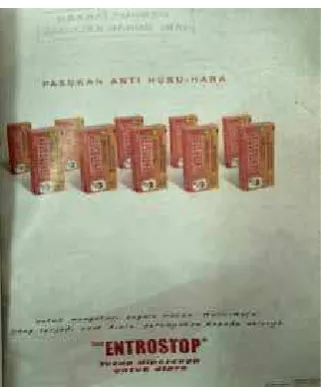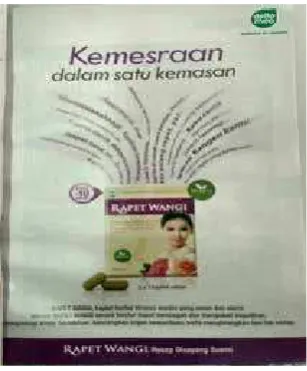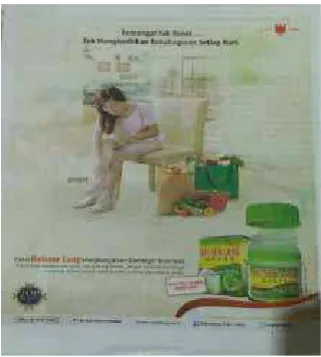IN PRINT ADVERTISING
Muchamad Sholakhuddin Al Fajri Maulana Malik Ibrahim State Islamic University
E-mail: [email protected]
DOI: http://dx.doi.org/10.17509/bs_jpbsp.v17i1.6953
Abstract
This study aims to examine the use of conversational implicatures(Grice, 1975) in print advertising. It analyses 10 advertisements taken from men and women English and Indonesian Magazines issued in 2016 and 2017. Since advertising is a form of communication between the few (advertisers or company) and the many (public), adverts are supposed to follow the Cooperative Principle and its maxims. However, advertisement designers often do not obey the maxims blatantly or lout the maxims which give rise to an implicature in order to achieve a certain communicative effect. I argue that the application of conversational implicatures in advertisements tends to provide enormous beneits for advertisers or company. The application can perform various functions which eventually make the adverts more effective and persuasive. It could make the adverts more economical or cost-effective, make the ad easy to be remembered, arouse the audience’s curiosity, attract and retain attention and make the advertisers able to avoid responsibility to defend the implied claims.
Keywords: conversational implicature, advertising, cooperative principle, louting maxims
FUNGSI-FUNGSI IMPLIKATUR PERCAKAPAN DALAM IKLAN CETAK
Abstrak
Penelitian ini bertujuan untuk menguji penggunaan implikatur percakapan (Grice, 1975) dalam iklan cetak. Data yang dianalisis adalah sepuluh iklan yang diambil dari majalah pria dan wanita berbahasa Inggris dan Indonesia yang terbit pada tahun 2016 dan 2017. Karena iklan adalah bentuk komunikasi antara pengiklan atau perusahaan dengan publik, iklan harus mengikuti teori prinsip kerja sama dan maksim. Namun, untuk mencapai efek komunikatif tertentu,perancang iklan seringkali tidak mematuhi maksim atau mengabaikan maksim yang menimbulkan implikatur. Penelitian ini menunjukkan bahwa penggunaan implikatur percakapan dalam iklan cenderung memberi banyak manfaat bagi pengiklan atau perusahaan. Penggunaannya dapat memenuhi berbagai fungsi yang pada akhirnya membuat iklan menjadi lebih efektif dan persuasif. Iklan pun menjadi lebih ekonomis atau hemat biaya, lebih mudah diingat, membangkitkan keingintahuan penonton, menarik dan mempertahankan perhatian serta membuat pengiklan mampu menghindari tanggung jawab untuk mempertahankan klaim tersirat.
INTRODUCTION
Advertising is pervasive in today’s world. We can easily ind it in any media such as newspapers, magazines, on television, billboards, etc. As Geis (1982) states, advertising is as omnipresent as the air we breathe. We are inevitably bombarded with various advertisements in our daily lives. Given this pervasiveness, it is likely that adverts will be easily ignored by audiences as some features of advertising are unsolicited and invasive, thrust upon the audience without consultation (Cook, 2001, p. 203). Advert designers, therefore, try to employ some tacticsto make ads more persuasive and to compete for costumers’ attention.
Although an advertisement is composed with verbal and non-verbal communication, language in adverts is considered as a powerful tool to achieve advertising goals. It is the main vehicle to convey messages to consumers and plays a vital role in facilitating people’s memory of desirability of products or services (Geis, 1982, p. 23). Similarly, Dyer (1982, p. 111) states that capturing our attention and imagination and assisting memory are probably the chief functions of advertising language. Advertising language thus is frequently exploited by advertisers.
Conversational Implicature, a linguistic technique, is arguably fruitful in assisting advertisers to achieve advertising goals. It has been used by advertisers as extra persuasive or manipulative means (Džanic, 2007) and due to the nature of implicature, it would continue to be an exploited linguistic device in advertising (Pop, 2010).This present study endeavours to explore the functions of conversational implicatures in advertising.It begins with a literature review which describes the idea of implicature and its correlation to advertising language. Then, the data and method will be presented before providing inding and discussion consisting of identifying conversational implicatures and scrutinising their functions in adverts. The
last section will present conclusion of this study.
The notion of implicature isirst introduced by Paul Grice in 1975 in the paper ‘Logic and Conversation’. Although it has sustained a number of criticisms, Grice’s theory has inluenced the development of pragmatics (Levinson, 1983; Thomas, 1995; Cummings, 2005; Huang, 2007). Grice applies the term implicature “to account for what a speaker can imply, suggest, or mean, as distinct from what the speaker literally says” (Brown & Yule, 1983, p. 31). Another scholar describes it as a proposition implied in an utterance ina certain situation,but it is not an entailment of what was actually said (Gazdar, 1979, 38).In this way, it can be generally stated thatimplicatures are what speakers intend to communicate to their interlocutor beyond what is literally said and entailments of the utterance.
As a matter of fact,Grice distinguishes two classes of implicature: “conventional implicature” and “conversational implicature”. Both types of implicature carry an additional level of meaning beyond semantic meanings of the utterance. What makes them different is the way both implicatures consider a context. While in conventional implicature what is implied is always the same irrespective of the context, in conversational implicature the implicature differs depending on the context (Thomas, 1995).However, the focus of this essay is only on conversational implicature. Since conversational implicatures are derived via Grice’s theory of Cooperative Principle (Birner, 2013, p. 44), this paper will then irstly discuss the theory.
isrequired, at the stage at which it occurs, by the accepted purpose or direction of the talk exchange in which you are engaged” (p.45). Thus, it can be said that people engaged in a conversation will work together by adhering to certain conversational rules to make meaningful interactions. However, it should be noted that Grice’s principle does not tell speakers how to interact, but he suggests that people in a conversation always presumes that a set of guidelines is in operation, unless they see contrary indications (Thomas, 1995: p. 62).
Further, Grice (1975) divides the CP into four maxims: quantity; quality; relation and manner. The irst maxim is the maxim of quantity, which is related to the amount of information provided by speakers. It suggests that speakers are expected to be as informative as required, providing neither too little nor too much information (Grice, 1975). The next maxim is the maxim of quality. It says that speakers should be sincere and make their contribution truthful and full of evidence (ibid.). The third is themaxim of relation. Speakers are expected to give relevant information to what has been stated before (Cutting, 2008: p. 35) and/or relevant to what happened in the situation (Birner, 2013: p. 54). The last is the maxim of manner. It refers to the clarity of speakers’ utterance. Speakers are supposed to say something briely and orderly and avoid obscurity and ambiguity (Grice, 1975).In short, the CP and its maxims ascertain that in a talk exchange speakers supply suficient, truthful and relevant information in a clear manner.
In this regard, in the advertisement context, it may suggest that advertisers should give required information (not too little or too much information) about the product, provide information which is true and has adequate evidence about the product, present something which is relevant to the product and avoid providing information which is obscure, ambiguous,and lengthy.
Although the CP and its maxims areassumed to be observed by speakers in a conversation, Grice also acknowledgesthe fact that in some occurrences, people may not adhere to the maxims. He argues that there are four ways where a speaker fails to obey the maxims. Those are clashing a maxim; violating a maxim; opting out a maxim; and louting a maxim (Grice, 1975).Additionally, Thomas (1995) proposes two other means: infringing a maxim and suspending a maxim. However, among various methods to break the maxims, louting is the only means that will lead to an implicature (Thomas, 1995).A lout occurs when maxims are not fulilled in an obvious way with the purpose to make the addressee search for a different or an additional meaning beyond the expressed meaning (Thomas, 1995, p.65).Grundy (2000) points out that louting maxim is a salient means of making a hearer draw an inference and therefore recover an implicature. The additional meaning which is generated from louting the maxims is what Grice calls ‘conversational implicature’.
additional meaning beyond what is literally said which is derived from assuming that the participants in a conversation adhere to the CP. For example,
A: Have you ever seen snowfall? B: My country only has summer and rainy seasons.
In this example, on the surface B says something which is obviously less informative and irrelevant to the A’s question. Thus, B has ostentatiously louted the maxim of quantity and relation. If B follows the maxims, the answer should be “yes” or “no”. Therefore, A must draw an inference to preserve the assumption of B’s cooperation. Given the shared knowledge that snow is mostly seen in winter season, the inference that is likely be drawn is that “B has never seen snowfall”.
It should be noted, however, Grice’s theory appears not to discuss a systematic process how the hearer calculates and then arrives at the intended one.In some circumstances, when the utterance has some possible implicatures, it could be dificult to determine which one is the intended implicature. It can be because sometimes speakers may convey more than one implicatureon purpose. In this case, Grice’s theoryseems not to discuss this situation.
Since advertising is a form of communication between the few (advertisers or company) and the many (public) (Dyer, 1982),it can be said that adverts are supposed to follow the CP and its maxims in order to make an effective interaction. However, advertisement designers often do not obey the maxims blatantly or lout the maxims which give rise to an implicaturein order to achieve a certain communicative effect.
Pop (2010) asserts that communication in advertising is dependant signiicantly on implicatures that assist to proceed towards ultimate interpretations by involving the reader in a process of inference-drawing. By
involving the addressee in the advertisements, advertisers allow the ads more persuasive rather than of open statements (Geis, 1982: p. 50) and make the audience’s attention retained for longer (Tanaka, 1994: p. 94). Moreover,implicatures will enable advertisersto conveycertain claimswhile unnecessarily defending them overtly. Geis(1982) in his own words states as follows:
It should be clear by now why the use of indirect means to convey claims is so attractive to advertisers (and other speakers as well): One doesn't have to defend such claims and consumers are less likely to defend against them than overtly made claims. There is another motivation for employing conversational implicatures. Since they have to be "worked out" by the listener, the listener
may ind them to be more persuasive
than asserted claims(Geis 1982: p. 50).
METHOD
The data of this present study aretexts selected from print advertisements. There are 10 adverts which areextracted from the latest issue ofboth men and women English magazines (December 2016- January 2017) and Indonesian magazines and tabloids in the last three months which have various topics. The reasons for selecting the data are thatimplicature can be applied in any language (Grice, 1975, 1989, 2011) and the richness of types and topics can help generalize the results of this study.
FINDINGS AND DISCUSSION
This section is devoted to providing the analysis of the advertisements. The focus is
on the identiication of implicatures hidden in the advertisements and the description of their functions.
Identiication of implicatures in the advertisements 1. Advert 1
Figure 1: Neo Entrostop Advertisement
(1) Pasukan Anti Huru-Hara TroopsAntichaos (1.1) Riot Police
(2) Untuk mengatasi segala macam huru-hara yang terjadi saat diare To treat all kinds chaos that occur when diarrhea
(2.2) to treat all kinds of chaos that occur when suffering from diarrhea
This is an advertisement of “Neo Entrostop”, a brand of medicine for diarrhea. The phrase “Riot Police” and the word “chaos” in this context blatantly lout the maxim of quality. As stated in section 2.2 speakers are not expected to say something false but here the advertiser says something that cannot be true with the application of metaphor. Using metaphor is one of the ways that a speaker can apply to lout the maxim of quality (Cutting, 2008: p. 36). In this case,the symptoms of diarrhea are metaphorically
2. Advert 2
Figure 2: Rapet Wangi Advertisement
(3) Kemesraan dalam satuk emasan Intimacy in one package (3.1) Intimacy is in one package
Here is an advert of ‘Rapet Wangi’ which is an herbal caplet to prevent and treat vaginal discharge and odor. his advertblatantly louts the maxim of quality. It louts the maxim of quality in the sense that the sentence (3.1) is obviously false. hey are the caplets that are in the package, not intimacy. It also can be seen that the ad louts the maxim of relation since on the level of what is said there is no direct relation between the sentence and the product. his will lead the reader to infer what the advertiser actually intends to convey. he reader may begin to think
3. Advert 3
Figure 3: Soneva advertisement
(4) Life is not about who you know, it’s about who you meet
his ad is by ‘Soneva’ which is a brand of ‘castaway’ resorts in the Maldives and hai. It appears that the quantity and relationmaxims are being louted in this advertisement. he sentence (4) is uninformative and irrelevant to the brand. Considering the context, the company may want to deliver an implied messagethat life
is not meaningful if you only know people outside without ever meeting them, so go travel and meet them. In this way, the advertiser seems to imply more speciically that the reader should go to the resorts in the Maldives and hai and meet many new people and experience new environment in order to feel real life.
4. Advert 4
he advert is by Dior J’adore, which is a brand of perfume. his advert clearly saves a lot of words with only using three words, excluding the name of the product. he information about the features of the product is not suiciently imparted. he noun phrase (5) is not informative enough and thus it does not fulil the maxim of quantity. Also, it can be argued that the advert disobeys the maxim of relation as the phrase (5) might not have any direct relation to the features of the product. hus, since it appears that the advertiser breaks the maxims in a blatant way, the audience will search for additional meanings. he implicit message that the
advertiser intends the audience to recover could be that by using the product, you will have the qualities of typical of women or be the absolutely most feminine woman. As stated in the section 2.3, an utterance can potentially have more than one implicature. In this instance, the deinite phrase ‘he absolute’ may trigger the reader to infer another implicature that other brands of perfume do not completely represent femininity. hus, what is actually the intended implicature of that utterance? It seems that both are the planned implicatures since both implicatures are beneicial for the company and seem not able to be cancelled.
5. Advert 5
Figure 5: Mie Sedaap Advertisement
(6) Bikin lidah menari-nari Make tongue dancing
(6.1) Make the tongue dancing
his is an advert of “Mie Sedaap”, a brand of an instant noodle. In this advertisement, it is noticeable that the writer louts the maxim of quality with the employment of personiication, assigning human characteristics to an inanimate entity (Ricoeur, 1986, p. 68). he sentence(6.1) is blatantly untruthful and lacks evidence since it is logically unfeasible that a tongue can dance. It thus forces the reader to look for another plausible interpretation, assuming that the advertiser is cooperative. he deductive
6. Advert 6
Figure 6: Mustang Ford Advertisement
(7) Go further
he picture is an advertisement of ‘Mustang Ford Car’. It can be seen that the company employs limited words in advertising. hese are the name of the product and the phrase (7). he phrase, which is also the brand tagline, gives less information about the product and it appears irrelevant. hus, the maxim of quantity (uninformative) and relation are both louted. Moreover, it might break the maxim of manner as well since the phrase can have some meanings or can be
ambiguous. Assuming cooperation, the audience will look for an additional meaning. In this context, people may infer several implicatures. First, it can be inferred that the Ford car is in a more advanced stage than any other cars or it will bring you further than any other cars. hen, the company may also want to convey that the product is more than what the reader expects from a car. heseimplicatures seem likely to be expected by the advertiser.
7. Advert 7
Figure 7: Balsem Lang Advertisement
(8) Semangat tak henti tuk menghadirkan kebahagiaan setiap hari Spirit not stop to present happiness every day
he advert above is the advertisement of “Balsam Lang”, which is a brand of balm. On the surface, the sentence (8.1) seem sun informative and not to have any direct relation to the product since the general knowledge of balm’s function is to treat injuries or reduce pain. It, thus, louts the maxim of quantity and relation. However, by doing this, the advertiser may
try to convey a message implicitly that weariness and injuries could break your spirit or enthusiasm so that you will not be able to be happy and give out happiness. herefore, in a such way if you use the product, it will help heal your pain or injuries with the result that they will not avert you from being happy and bringing happiness to other people.
8. Advert 8
Figure 8: Pixy Two Way Cake Cover Smooth Advertisement
(9) Jadikan pandangan autofocus pada wajahmu Make gaze autofocus on your face
(9.1) Make (imperative) gazes autofocus on your face
his is an advertisement of “Pixy Two Way Cake Cover Smooth” which is a cosmetic product, face powder. he advert breaks the maxim of quantity (uninformative) and relation. here are no clues and information provided to make the audiences understand what things thatcanmake gazes autofocus on their face and how to do it. hus, assuming the
9. Advert 9
Figure 9: TAG Heuer Advertisement
(10) Don’t crack under pressure his advert is by TAGHeuer, which is a brand name of watch. It appears that the ad louts several maxims. In relation to the maxim of relation, the sentence (10), which is verbal prohibition, seems not to have any relation to the product. It also could be not too informative as the audience might prefer to know more about the feature of the product. It thus obviously breaks the maxim of quantity and relation. Assuming cooperation, the reader may infer several implicatures from this advert. It might be
inferred that the product is worn by successful people who never give up in a diicult situation but this less likely. Also, the reader may infer that the brand continues to break its limits and never cracks under pressure, such as marketing pressure. Additionally, it may be inferred literally that the product will not be cracked under physical force. All potential implicatures are not likely able to be cancelled and it seems diicult to determine the intended one.
10. Advert 10
Figure 10: BRITA advertisement
The advert above is by BRITA, which is a brand of a water ilter bottle. Looking at the advert, the interrogative sentence (11)tends to be a rhetorical question which is not sincerely asked by the advertiser.In this context, the advertiser appears not to ask genuinelyyour reasons for always buying a bottle when thirsty. It, therefore, ostentatiouslylouts the maxim of quality. Geis (1982) states that in advertising,rhetoricalquestions with the interrogative adverb why typically imply “corresponding declarative propositions with the modal verb should”. Therefore, an implied meaning of the sentence couldbethat you should not buy a bottle every time you are thirsty.
Having analysed all the advertisements, it can be seen that the advertisers still can reach marketing objectives although they do not fulil the maxims. Moreover, while it is stated that it is feasible to determine the intended implicature of the utterance, this study shows that sometimes it is dificult to calculate the intended one. It seems that advertisers, in some circumstances, intentionally convey several implicatures to leave the readers in somewhat confusion and may then arouse their curiosity, which is eventually advantageous for the company.
Functions of conversational
implicaturein discourse of advertising Several scholars have asserted that the u se of implicature in advertising is advantageous for advertisers or company (Tanaka, 1994; Geis, 1982; Pop, 2010; Liu, 2012). One of the most beneicial functions is presumably related to the economy of language. This frequently occurs when the writer louts the maxim of quantity in the sense of providing less information to create an implicature. Advertisers often deliberately give less information than required which leads to an implicature in order to enable them to convey additional information without consuming valuable word space. This
strategy inevitably reduces cost for advertising. As Pop (2010: p. 7) points out, conversational implicature is employed in advertising “to make readers draw inferences beyond what was originally stated, and thus sell more meanings at the price of one word”. Although advert 4, for instance, uses only few words which make it give less information than required, louting the maxim of quantity, it still can convey more information and messages to the reader. It still can communicate that ‘the perfume will make you have qualities of feminine women’ without overtly asserting it.
Besides saving word space, this technique is likely to be valuable for aiding consumers to memorise the product and arousing people’s curiosity (Liu, 2012). For example, advertisement 6 only exercises two words which can be easily remembered by the reader and may still achieve promotional goals. This also tends to raise people’s desire to know more about the product as the audience may also wonder what the company actually means by ‘go further’ and then search for more information which my result in trying to purchase the product.
audience presumably will pay attention to the advert longer.
Lastly, the fact that advertisers use implicature to make a claim covertly can give a further advantage. Since implicatures are not explicitly stated, this allows speakers to deny that they intended to convey such meanings (Yule, 1996). Advertisers can avoid the responsibility to defend the claim since the audience is also involved in inferencing the assumption so that it is partly the audience’s responsibility. Advertisers do not require to defend inferences drawn by the audience (Geis, 1982) and can, if required, deny that they intend to communicate that assumptions (Tanaka, 1994). For example, advert 2 does not explicitly convey that the product can create intimacy in a sexual relationship and advert 8 does not say that the product will make people beautiful and make gazes autofocus on their face. Also, advert 4 does not state explicitly the claim that other brands of perfume do not completely represent femininity. Thus, If the consumers make complaints about the claims, the advertisers mightbeable to avoid responsibility and may deny that they implied the claims.
CONCLUSION
This study sought to analyse the use of conversational implicatures in advertising. The results suggest that the employment of implicature stends to provide enormous beneits for advertisers or company. Advertisers do not observe the cooperative principle and its maxims blatantly to create speciic effects and achieve promotional goals. It also demonstrates that, in some circumstances, it is dificult to calculate the intended implicature, and advertisers may intend to convey more than one implicature to raise people’s curiosity.
Moreover, it has been shown that the application of implicatures can perform various functions in advertisements, which eventually make the adverts more effective
and persuasive. It could make the adverts more economical or cost-effective by saving word space, make the ad easyto be remembered by the reader, arouse the audience’s curiosity, attract and retain attention and make the advertisers able to avoid responsibility to defend the implied claims.
However, there are still limitations in this paper. The data of this study are very small and limited. Thus, this study may not be able to demonstrate that implicatures are widespread in the discourse of advertising. Moreover, it seems that it would be more convincing if public opinions about the persuasive function oimplicatures in advertising aretaken into account. Therefore, it could be suggested that the future research couldusealarger number of advertisements and also conduct some interviews with the public about the persuasiveness of advertisements employing implicatures.
ACKNOWLEDGMENTS
I would like to express my deep gratitude to Dr Claire Hardaker for her valuable feedback on the earlier version of this manuscript, and the anonymous reviewers for their constructive comments. I am also immensely grateful to Indonesia Endowment Fund for Education (LPDP) for funding my study at Lancaster University.
REFERENCES
Birner, B. J. (2013). Introduction to pragmatics: Chichester, West Sussex, UK : Blackwell.
Brown, G., & Yule, G. (1983). Discourse analysis. Cambridge: Cambridge
University Press.
Cook, G. (2001). The discourse of advertising (2nd ed.). London: Routledge.
Cutting, J. (2008). Pragmatics and discourse : a resource book for students (2nd ed.). Abingdon: Routledge.
Dyer, G. (1982). Advertising as communication. London & New York: Routledge. Gazdar, G. (1979). Pragmatics : implicature,
presupposition and logical form. New York: Academic Press.
Geis, M. L. (1982). The language of television advertising. New York: Academic Press.
Grice, H. P. (1975). Logic and Conversation. In P. Cole & J. L. Morgan (Eds.), Syntax and Semantics 3: Speech Acts (pp. 41-58). New York: Academic Press. Grice, H. P. (1989). Studies in the way of words. Cambridge, Massachusetts:
Harvard University Press.
Grice, H. P. (2011). Logic and Conversation. In D. Archer & P. Grundy (Eds.), The Pragmatics Reader (pp. 43-54). Abingdon: Routledge.
Grundy, P. (2000). Doing pragmatics (2nd ed. ed.). London: Hodder Arnold.
Huang, Y. (2007). Pragmatics. Oxford: Oxford University Press.
Kempson, R. M. (1977). Semantic theory. Cambridge & New York: Cambridge University Press.
Levinson, S. C. (1983). Pragmatics. Cambridge: Cambridge University Press.
Levinson, S. C. (2001). Pragmatics: Cambridge: Cambridge University Press.
Liu, F. (2012). A Study of Principle of Conversation in Advertising Language. Theory and Practice
in Language Studies, 2(12), 2619-2623. doi:10.4304/tpls.2.12.2619-2623 Mey, J. (1993). Pragmatics : an introduction.
Oxford, UK: Blackwell.
Ricoeur, P. (1986). The rule of metaphor : multi-disciplinary studies of the creation of meaning in language. London: Routlege. Tanaka, K. (1999). Advertising language: A
pragmatic approach to advertisements in Britain and Japan: Psychology Press. Thomas, J. (1995). Meaning in interaction : an
introduction to pragmatics. London; New York: Longman.






